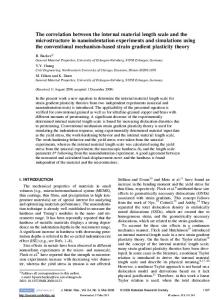Relationship between the microstructure and nanoindentation hardness of thermally evaporated and magnetron-sputtered ele
- PDF / 384,028 Bytes
- 8 Pages / 612 x 792 pts (letter) Page_size
- 87 Downloads / 331 Views
Tungsten oxide (WOx) films were fabricated by (i) reactive thermal evaporation (RTE) at room temperature with oxygen ambient pressure PO2 as a parameter, and (ii) reactive magnetron sputtering (RMS) with substrate temperature Ts as a parameter. The film structure revealed by x-ray photoelectron spectroscopy, x-ray diffraction, density measurements, infrared absorption, and atomic force microscopy was correlated with the nanoindentation hardness H. The RTE WOx films deposited at high PO2 were amorphous and porous, while H depended appreciably on normalized penetration depth hD (indentation depth/film thickness) due to the closing of the pores at the point of indentation. Decrease in PO2 from 10 to 2 × 10−3 mtorr led to smaller porosity, weaker hD dependence of H, and higher average H (measured at hD ≈ 0.2 to 0.3, for example). The RMS WOx film deposited at room temperature was amorphous and denser than all RTE films. The rise in substrate temperature Ts first densified the film structure (up to 110 °C) and then induced crystallization with larger grain size for Ts 艌 300 °C. Correspondingly, the hD dependence of H became weaker. In particular, H of the RMS sample deposited at 110 °C showed a peak at hD slightly above 1 owing to pileup at the contact point of indentation. For higher Ts, pileup occurred at shallower hD and the average H (measured at hD ≈ 0.2 to 0.3, for example) rose, accompanied by the increase of grain size.
I. INTRODUCTION
Tungsten oxide (WOx) is of great potential in the application of electrochromic devices (ECD) because of its high coloration efficiency.1–9 In the past few decades, great effort has been made to investigate the relation between the fabrication techniques and conditions, microstructure, electrochromic properties, and degradation mechanisms in WOx films during color–bleach (c/ b) switching cycles. It is found that the fabrication techniques and conditions indeed have a strong influence on the microstructure, which in turn governs the electrochromic behavior and degradation of the films.10 On the other hand, the mechanical properties of WOx films have received relatively little attention, but they deserve more investigation because they are also closely related to the microstructure and can affect the durability and stability of the devices associated with any mechanical damages. The objective of this work was to study the relation between the microstructure and the mechanical properties of WOx films fabricated by techniques, namely, reactive a)
Address all correspondence to this author. e-mail: [email protected] J. Mater. Res., Vol. 16, No. 6, Jun 2001
http://journals.cambridge.org
Downloaded: 17 Aug 2015
thermal evaporation (RTE) and reactive magnetron sputtering (RMS), under different conditions. For the RTE processes, oxygen ambient pressure was varied as a parameter, while the substrate temperature was kept at 25 °C. For the RMS processes, substrate temperature was the main preparation parameter. Cyclic voltametry (CV) was employed to illustrate the electrochromic pr
Data Loading...










